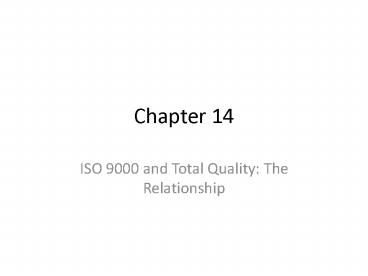ISO 9000 and Total Quality: The Relationship - PowerPoint PPT Presentation
1 / 10
Title:
ISO 9000 and Total Quality: The Relationship
Description:
Chapter 14 ISO 9000 and Total Quality: The Relationship Objectives After reading the chapter and reviewing the materials presented the students will be able to ... – PowerPoint PPT presentation
Number of Views:773
Avg rating:3.0/5.0
Title: ISO 9000 and Total Quality: The Relationship
1
Chapter 14
- ISO 9000 and Total Quality The Relationship
2
Objectives
- After reading the chapter and reviewing the
materials presented the students will be able
to - Understand ISO 9000 Quality Management System
- Compare ISO 9000 and Total Quality Management
3
ISO 9000 Basics
- ISO 9000 is based on 8 principles
- 1. Customer Focus Understand customer needs,
meet customer requirements, and strive to exceed
customer expectations. - 2. Leadership Establish unity of purpose and
organizational direction. - 3. Involvement of people Use abilities of
employees for the benefit of the organization. - 4. Process approach Things accomplished are the
results of processes and processes and resources
must be managed. - 5. System approach to management Multiple
processes contribute to system and should be
managed as a system. - 6. Continual improvement Of people, processes,
systems and products. - 7. Factual approach to decision making Decisions
must be based on the analysis of accurate,
relevant, and reliable data and information. - 8. Mutually beneficial supplier relationships
Both the organization and the supplier benefiting
from each others resources and knowledge results
in value for all.
4
Origins of ISO 9000 and TQM
- Dr. Edward Deming introduced the
Plan-Do-Check-Act (PDCA) cycle to the Japanese in
1950 and it became one of the seeds of the
Japanese quality revolution that gave us TQM. - PDCA has made its way to ISO 9000 and is said to
be the operating principle of ISOs management
system standard. - Its function is to operate as a never ending loop
resulting in continual improvement for products,
services, processes and systems.
5
Aims of ISO 9000
- The original aim of ISO 9000 was to ensure that
the products or services provided by registered
organizations were consistently fit for the
intended purpose. - Customer focus and continual improvement have
been added to make the registered organizations
more competitive. - This is essentially the same objective of total
quality management.
6
ISO 9000 and TQM are not Interchangeable
- Although ISO 9000 made a great leap towards TQM
with its 2000 release, they are not yet the same
(fig 14-3, page 237). - TQM is defined as an approach to doing business
that attempts to maximize the competitiveness of
an organization through the continual improvement
of the quality of its processes, products,
services, people, and environments.
7
Management Motivation for Registration to ISO 9001
- To improve operations by implementing a quality
management system that satisfies the ISO 9000
requirements for management responsibility
resource management, product realization,
measurement, analysis, and continual improvement. - To create or improve a quality management system
that will be recognized by customers worldwide. - To improve product or service quality or the
consistency of quality. - To improve customer satisfaction.
- To improve competitive posture.
- To confirm the requirements of one or more major
customers.
8
ISO 9000 and TQM Working Together
- ISO 9001 registration can be a good first step
into TQM. - ISO 9000 registration often is the most practical
route to demonstrate compliance for European
regulations with a quality system element.
9
Summary
- Dr. Edward Deming introduced the
Plan-Do-Check-Act (PDCA) cycle to the Japanese in
1950 and it became one of the seeds of the
Japanese quality revolution that gave us TQM.
PDCA has made its way to ISO 9000 and is said to
be the operating principle of ISOs management
system standard. Its function is to operate as a
never ending loop resulting in continual
improvement for products, services, processes and
systems. - The original aim of ISO 9000 was to ensure that
the products or services provided by registered
organizations were consistently fit for the
intended purpose. Customer focus and continual
improvement have been added to make the
registered organizations more competitive. This
is essentially the same objective of total
quality management. - TQM is defined as an approach to doing business
that attempts to maximize the competitiveness of
an organization through the continual improvement
of the quality of its processes, products,
services, people, and environments. - ISO 9001 registration can be a good first step
into TQM. - ISO 9000 registration often is the most practical
route to demonstrate compliance for European
regulations with a quality system element.
10
Home Work
- Answer Questions 1, 3 on page 241.
- 1. List 6 statements that summarize the
comparative scope of ISO 9000 and TQM. - 3. Contrast the aims of ISO 9000 and TQM.































